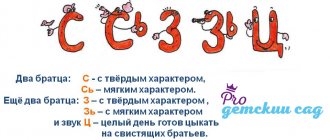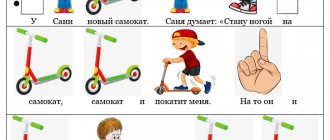One of the problems in the development of a child’s speech is the production of the sound L. Many exercises have been developed to develop correct pronunciation. It is better to perform them under the supervision of a speech therapist. Once the pronunciation skill has been developed, it needs to be automated. Training can take a long time.
To make the sound “L”.
What is lambdacism and its varieties
Lambdaism is usually called the incorrect pronunciation of the sound L or its complete loss in speech.
There are several types of this violation:
- Nasal - when you exhale, the air flows through the nose. The reason for this pronunciation is that the soft palate is in contact with the root of the tongue. Instead of "lamp" it becomes "ngampa".
- Bilabial - when pronouncing, the labial muscles tense; instead of the desired sound, the child pronounces “u” - “uapata” instead of the word “shovel”.
- Interdental - the tip of the tongue falls out between the teeth.
- Lower - the tongue rests on the lower teeth. This variety is the most difficult to correct.
- Fricative - instead of the desired sound, a softened (“Ukrainian”) G is obtained.
Replacing the sound L with others is called paralambdacism.
The most common types of replacement:
- B - “vuk” instead of “bow”;
- D - “dozhka” instead of spoon;
- Y - “yampa” instead of “lamp”;
- soft L - “plait” instead of “raft”.
Some children experience a complete loss of the L sound. Instead of the word “fox,” they pronounce “isa.”
Why doesn't the child pronounce [l]?
Usually, by the age of 5-6 years, children pronounce almost all sounds. But quite often you can find children (and adults) whose pronunciation of the sounds [l] and [l'] is impaired. Moreover, producing a solid sound is difficult.
The reasons for incorrect pronunciation are different. Often this is the result of parents lisping with the baby, repeating words after the baby, and the desire to “chat in the child’s language.” This problem is also relevant in bilingual families where Russian is not their native language. Of course, if the parents themselves do not pronounce certain sounds, then their children will speak the same way.
There may also be physiological factors - problems with hearing, with proper breathing, the structure of the articulatory apparatus. Very often, a child does not pronounce [l] due to a short frenulum of the tongue, but with the help of special exercises it can be stretched (and not cut, as was done before).
By the way, parents’ request to teach their child to “pronounce the letter “L” is not entirely correct. We pronounce sounds and use letters to designate them when writing.
Difficulty pronouncing the sound [L]
Incorrect pronunciation of the sounds [l] and [l'], their omission in speech are designated by the term lambdacism.
Types of lambdacism:
- bilabial, when the sound is pronounced only with the lips and instead of “l” the result is “u” (“uampa” instead of “lamp”);
- nasal, in which, due to the incorrect position of the tongue, the air flow rushes into the nose and [l] sounds like [ng] (“ngampa”);
- interdental – if the tip of the tongue is between the teeth;
- the sound in speech is omitted (“ampa”).
Replacing hard [l] with other sounds is called paralambdacisism. These include:
- replacement with [g] - “gastochka” (“swallow”), “guna” (“moon”);
- replacement with [v] - “mavysh” (“baby”), “yabvoko” (“apple”);
- replacement with [d] - “doshad” (“horse”), “dyzhi” (“skis”);
- replacing with [j] - “yomtik” (“slice”);
- replacement with [u] - “usichka” (“chanterelle”);
- a situation when a child softens the sound by saying [l'] - “lampa” (“lamp”).
These pronunciation deficiencies can be corrected by doing simple, entertaining exercises every day.
What are the reasons for the incorrect pronunciation of L?
Until the age of 4, the speech apparatus is not adapted to pronouncing this sound, so lambdaism at this age is considered a variant of the norm.
There are several reasons why a child speaks incorrectly:
- Improper breathing during speech.
- Disturbances in the development of speech hearing - the child has difficulty hearing the speech of other people and does not perceive meaning well.
- Insufficient development of the articulatory apparatus, weakness of facial muscles and tongue. These muscles play a leading role in the pronunciation of sounds.
- Deviations in the structure of the hyoid ligament (frenulum) - speech disorders are possible if the ligament is short.
Improper breathing can be due to several factors:
- The child's lung capacity is reduced.
- The respiratory muscles are weak, so the child cannot speak loudly.
- When exhaling, the air stream comes out in jerks, so it becomes difficult to finish a long sentence.
- Incorrect distribution of air, resulting in inhalation starting in the middle of the word.
4 How to properly conduct classes at home
We have already noted that the best way to teach something to a child 4-5 years old and a little older is through play. Therefore, you should not persist too much and turn speech therapy at home into torment. Everything should happen as if by itself.
At the initial stages, such exercises should be performed no more than 1-2 times a day, after which they can be increased to 3-4.
Be sure to show everything by your own example. Remember that you are the most important person for your baby. Mentor, friend and assistant all rolled into one.
Don’t forget to praise and enjoy your child’s progress, and don’t scold him if something doesn’t work out for him. This way you can discourage him from wanting to study. In addition, do not be afraid to explain to your son or daughter why and why you are doing all this. The child must realize that mom and dad always act solely in his interests.
How to position your tongue and lips
Articulation of the sound "L".
In most children, lambdaism is associated not with anatomical disorders of the speech apparatus, but with incorrect positioning of the lips and tongue.
To achieve correct pronunciation, you must follow these rules:
- Make sure that the upper teeth do not touch the lower teeth. There should be a narrow space between them.
- The sides of the tongue should not touch the upper molars. This will ensure proper breathing.
- The tip should be firm and rest on or just above your upper teeth.
- The area at the root should be slightly raised.
- The upper palate is slightly raised so that air cannot enter the nasal cavity when exhaling.
- The vocal cords vibrate and create the vocal sound.
The position of children's lips depends on what sound follows L.
What mistakes can there be when trying to pronounce L?
If a child tries to pronounce the sound L, the following errors are possible:
- The tongue goes deep into the oral cavity, its tip does not come into contact with the upper teeth or gums. Instead of the desired sound, the child produces Y (“boat” - “yodka”).
- A sharp breath at the moment when you need to say the right sound. If the muscles of the cheeks are involved in the process, the phoneme F is obtained.
- The air flow passes into the nose, so it turns out to be N.
Sometimes the child is first given R and then L. In such a situation, the second sound can replace the first (“rune” instead of “moon”)
When is the help of a speech therapist needed?
Sometimes home exercises to correct sounds do not produce results, the reasons may be the following:
- Russian is not the family’s native language, so adults speak with an accent;
- the baby was unable to master correct pronunciation after long exercises;
- someone from the adult environment has a diction defect and cannot conduct classes.
Since you couldn’t fix the problem yourself, you should seek the help of a specialist. Producing sounds is a special skill that only comes with experience.
The speech therapist will examine and listen to the little patient and offer to attend individual classes or group training. The task of parents is to be able to captivate the child by stimulating him to attend trainings. Even if the baby is not yet successful, he still needs to be praised and supported emotionally.
Preparing for the exercises
Before starting the training, the child is shown how L should sound correctly. Several words are pronounced with clear articulation. The child should see how the lips and tongue are positioned. They name several words that contain this letter, and ask them to determine by ear which part of the word it is in.
To form the correct passage of air, do breathing exercises.
Mistakes a child makes.
Then the child is asked to perform preparatory exercises:
- "Hammock". The tip of the tongue rests on the upper front teeth. Curl your tongue so that it resembles a hammock and hold it in this state for some time. Can be done on account.
- "Yummy". Using a wide tongue, lick your upper lip from top to bottom. The lower lip should not move.
- "Turkey". The exercise is similar to the previous one, but somewhat more complicated. It is performed at greater speed. You can add the pronunciation of the combinations “bl-bl-bl”.
- "Horse". The tongue is made wide, raised and flicked across the palate. The mouth is slightly open, the lower jaw should remain motionless. This exercise is useful to do when it is difficult for a child to hold his tongue suspended and rest the tip on the upper teeth.
- "Swing". The mouth opens slightly, you need to smile widely. The tip of the tongue should be firm. The next exercise is done by counting. At “one time” the tongue rises, the tip rests on the upper row of teeth (the back surface of the incisors). On the count of two, the tip rests on the lower teeth. The exercise is repeated several times.
- "Fungus". The back of the tongue is pressed against the hard palate, it becomes like a mushroom cap. Fix in this position and hold for 5-10 seconds. The bridle should be slightly taut.
This complex is performed at least 2 weeks before the start of sound production.
Articulation gymnastics
The set of exercises for setting includes tasks similar to those in the preparatory stage, but they are somewhat more complicated:
- "Window". The mouth is wide open, the teeth are slightly parted, and the tongue lies at the bottom of the mouth. The jaws are motionless and slightly tense. The position is held for up to 5 – 10 seconds;
- "Ladle". The tongue sticks out, and its tip bends like a ladle. The middle part of the tongue does not touch the upper teeth. The position is fixed for a few seconds, then the tongue relaxes and retracts into the mouth. You need to do several repetitions;
- "Panicle". The curved and tense tip of the tongue needs to be moved across the palate at different paces, gradually connecting the voice. The jaw does not move, the teeth are visible;
- "Cup". We make the tongue a “broom”, as in the previous exercise, reaching the palate with the curved tip at the alveoli. The lips take on an oval shape;
- "Harmonic". The tongue is applied to the palate, after which the mouth must be opened and closed, stretching the ligaments well.
The exercises are aimed at increasing the motor activity of the tongue, practicing the desired position, increasing tone and improving the elasticity of the hyoid ligament.
How to make the sound L
After completing the preparatory stage, they move on to the main exercises.
Staging L is carried out:
- by imitation;
- on inspiration;
- by mechanical means.
When the child begins to pronounce the letter correctly, it is necessary to consolidate this skill and bring it to automaticity. First, the child needs to be taught a soft sound, then a hard one.
By imitation
The most common method of learning is through imitation of an adult. First, the parent or speech therapist shows how to properly position the tongue and lips.
To make it clearer to the child, you can first explain to him in words:
- The language needs to be made broad.
- The tip is pressed against the upper front teeth or gums.
- The middle of the tongue is bent downwards, and the root is raised.
- Do not raise the side parts so that air can pass between them and the cheeks.
To check for correctness, touch the cheeks while the child says L. If everything is done correctly, the cheek muscles vibrate slightly.
It is better to practice in front of a mirror. First, the adult says it correctly himself several times, then asks the child to repeat it.
Automation of the sound “L” in phrases.
On inspiration
Exercises to develop correct articulation are combined with breathing exercises. It is advisable to put L while inhaling.
Before starting the workout, do several breathing movements:
- Inhale quickly - 1 second.
- Exhale smoothly and slowly - up to 5 seconds.
Then you can complicate the exercise and present it in the form of a game. The ratio of inhalation and exhalation should be maintained.
The complex for each child is selected individually and may include the following exercises:
- Blow on the pinwheel and watch it spin.
- "Stop a running horse." Inhale, lips relax. The air is exhaled to make a “prrrrr” sound.
- The child lies on his back on a flat surface (floor or hard couch). The hand is placed on the stomach. Inhale and inflate your stomach. The hand should feel how, as you inhale, “the ball inflates”, and as you exhale, it “deflates.”
- You can ask your child to close his eyes and guess the smell of fruits or other objects. As you inhale, you need to smell the fruit, drawing in air through your nose. As you exhale, pronounce the name of the object.
With mechanical assistance
To set the sound correctly, you can use mechanical devices:
- spatula;
- special probes;
- wooden ice cream stick;
- handle of a spoon, etc.
If there are no suitable objects at home, you can help the child with your fingers. The main task of such work is to fix the organ or muscle in the correct position.
Using improvised means, do the following exercises:
- A wooden stick is placed across the tongue. In this way, space is created between the upper molars and the sides of the tongue. The correct passage of air through the oral cavity is formed.
- Setting a hard sound from a soft one is done using the thumb. To do this, place the fingertip in the hollow under the chin. Lightly press on this area, and the sound reflexively becomes hard.
- You can learn to pronounce a hard phoneme by pressing the back of your hand to the bottom of your chin.
- If the child is overly tense, you can relax the facial muscles a little by massaging them with your fingertips.
- To correct bilabial lambdacism, the corners of the lips are stretched to a smile position and held in this state with the index fingers.
You can relieve tension by smacking your lips, exhaling through your mouth full through closed teeth - “oof”, snorting.
Words for practicing the sound “L”.
How to make correct pronunciation automatic
Once the correct pronunciation has been established, it needs to be reinforced. This process is difficult and time consuming for children. At home, it is enough to practice a few minutes a day in the morning and evening. It will be better if the lessons take the form of a game.
Soft L
The child often misses the soft L and even entire syllables with its participation. Therefore, it is better to start speech therapy exercises for sound from this moment.
To begin with, the pronunciation of syllables is fixed. Then you can move on to words. Individual syllables can be reinforced using special tongue twisters.
Examples are given in the table
| The syllables are simple | Complex syllables | Example words | Tongue Twisters |
| La | Blah, blah, blah, blah, blah | Fields, Kolya, Tolya, poplars | La-la-la - cold earth |
| Liu | Slue, peck, spit, flu, glu | Lucy, buttercup, hatch | Lu-lu-lu - I light the stove |
| Lee | Sli, kli, pli, fly, glee | Lida, linden, fox, lemon | Li-li-li - found a lemon |
| Le | Sle, cle, ple, fle, gle | Lena, laziness, forest | Le-le-le - everything is in ash |
| Le | Sle, cle, ple, fle, gle | Flax, light, bag |
When the child begins to develop straight syllables, you can move on to reverse ones. First, individual sound combinations are worked out, then they move on to whole words and tongue twisters.
| Simple syllables | Example words | Tongue Twisters |
| Al | Coat, tracing paper | |
| Spruce | Drops, jelly | Spruce-spruce - drops outside the window |
| Ol | Mole, salt | Ol-ol - a moth flew in |
| Uhl | Glug, glug, glug | Ul-ul - hung tulle |
| Eul | Dust, soap | Eul-eul - palms soapy |
| Yul | July, tulle |
Solid L
It is somewhat more difficult to teach a child to say hard L. To automate the sound, the same techniques are used as for soft ones. But it may take more time to consolidate.
Exercises for making the sound “L”.
You need to master correct speech in stages:
- First, the baby learns to speak syllables - Le, Lo, Ly, La, Lu.
- Then the combinations can be complicated with other consonants - Sla, Fly, Klo, Glu, Ple, etc.
- After direct syllables they move on to reverse ones - Al, Ol, Ul, Yl, El.
- When the combinations of letters are firmly fixed, they move on to whole words - boat, lamp, skis, moon.
Children can be offered pure tongue twisters and tongue twisters:
- lu-lu-lu - a puddle on the floor;
- la-la-la - swept up the trash;
- lo-lo-lo - there was a broom;
- near London - the lair of a sorcerer;
- put the coal in the corner.
When training, it is advisable to avoid combinations with the letter R. These letters are especially difficult for children to pronounce, they are often confused.
Exercises to improve speech hearing
To develop speech hearing, speech therapists recommend playing games with your child:
- They suggest speaking the words first quietly, then with medium force, then loudly. You can show toys and give tasks - a small toy speaks quietly, a large one speaks loudly, then vice versa.
- They read fairy tales by role, where the characters speak in different voices - quietly or loudly, in a low or high voice.
- The child is shown pictures and named them. Some names are misspelled. If the player notices a mistake, he raises his hand or claps his hands.
- An adult shows a picture and says several similar words. Among them you need to choose one correct one (bow - meadow - hatch).
- The parent or teacher names a generalizing word. Children are asked to name examples of words from the named group. They should contain the letter L (fruits - lemons, apples, trees - maple, linden, etc.).
Training must be carried out systematically. Game activities can be supplemented with musical accompaniment.











